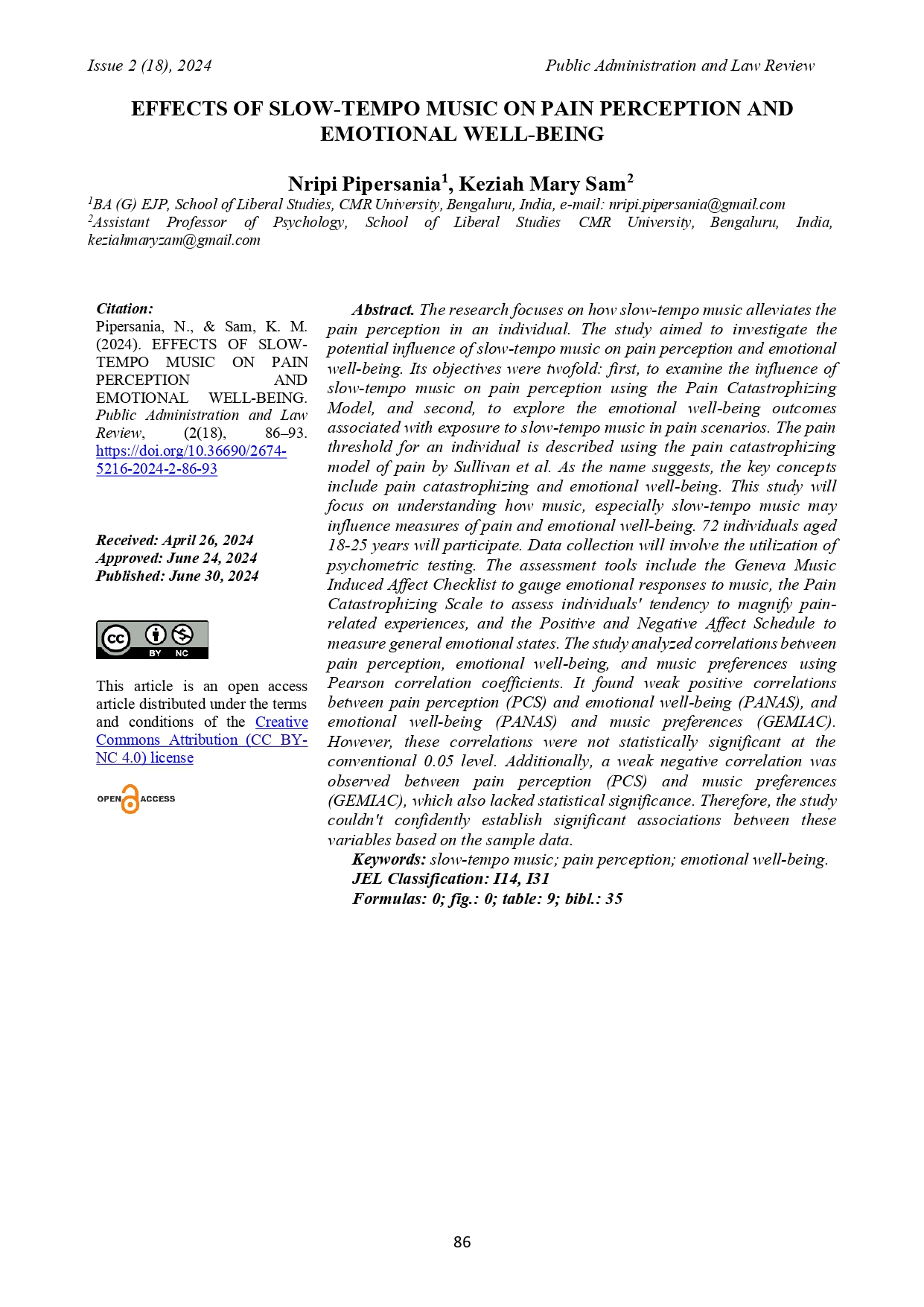EFFECTS OF SLOW-TEMPO MUSIC ON PAIN PERCEPTION AND EMOTIONAL WELL-BEING
DOI:
https://doi.org/10.36690/2674-5216-2024-2-86-93Keywords:
slow-tempo music, pain perception, emotional well-beingAbstract
The research focuses on how slow-tempo music alleviates the pain perception in an individual. The study aimed to investigate the potentialinfluence of slow-tempo music on pain perception and emotional well-being. Its objectives were twofold: first, to examine the influence of slow- tempo music on pain perception using the Pain Catastrophizing Model, and second, to explore the emotional well-being outcomes associated with exposure to slow-tempo music in pain scenarios. The pain threshold for an individual is described using the pain catastrophizing model of pain by Sullivan et al. As the name suggests, the key concepts include pain catastrophizing and emotional well-being. This study will focus on understanding how music, especially slow-tempo music may influence measures of pain and emotional well-being. 72 individuals aged 18-25 years will participate. Data collection will involve the utilization of psychometric testing. The assessment tools include the Geneva Music Induced Affect Checklist to gauge emotional responses to music, the Pain Catastrophizing Scale to assess individuals' tendency to magnify pain-related experiences, and the Positive and Negative Affect Schedule to measure general emotional states. The study analyzed correlations between painperception, emotional well-being, and music preferences using Pearson correlation coefficients. It found weak positive correlations between pain perception (PCS) and emotional well-being (PANAS), and emotional well-being (PANAS) and music preferences (GEMIAC). However, these correlations were not statistically significant at the conventional 0.05 level. Additionally, a weak negative correlation was observed between pain perception (PCS) and music preferences (GEMIAC), which also lacked statistical significance. Therefore, the study couldn't confidently establish significant associations between these variables based on the sample data.
Downloads
References
Bernatzky, G., Presch, M., Anderson, M., & Panksepp, J. (2011). Emotional foundations of music as a non-pharmacological pain management tool.
Cepeda, M. S., Carr, D. B., Lau, J., & Alvarez, H. (2006). Music for pain relief. Cochrane
Database of Systematic Reviews, (2), CD004843. doi:10.1002/14651858.CD004843.pub2
Eccleston, C., & Crombez, G. (1999). Pain demands attention: A cognitive–affective model of the interruptive function of pain.
Gabrielsson, A. (1995). Strong experiences with music: Music is much more than just music.
Garza-Villarreal, E. A., Brattico, E., Leaver, A. M., & Vogt, B. A. (2014). Music reduces pain and increases functional mobility in fibromyalgia.
Hsieh, C. Y., Phillips, R., Davis, R. B., & Cherkin, D. C. (2005). Music therapy for patients who have chronic pain. Alternative Therapies in Health and Medicine, 11(5), 52-60.
Knight, W. E. J., & Rickard, N. S. (2001). Relaxing music prevents stress-induced increases in subjective anxiety, systolic blood pressure, and heart rate in healthy males and females.
Kumar, R., Gupta, S. K., Sipahi, E., & Mohan, C. (2020). Professional Stress On The Work Place For Nursing Staff: Cause And Effect. Public Policy And Community Development In Stressful Situations, 13.
Lamont, A. (2011). University students’ strong experiences of music: Pleasure, engagement, and meaning.
Lu, X., et al. (2023). Historical and cultural context of music therapy in pain management. McCaffery, M. (1992). Nursing management of the patient with pain.
Mitchell, L. A., MacDonald, R. A. R., & Brodie, E. E. (2006). A comparison of the effects of preferred music, arithmetic, and humour on cold pressor pain.
Mitchell, L. A., MacDonald, R. A. R., Knussen, C., & Serpell, M. G. (2008). The role of musical engagement in pain perception.
North, A. C., & Hargreaves, D. J. (2008). The social and applied psychology of music.
Quartana, P. J., Campbell, C. M., & Edwards, R. R. (2009). Pain catastrophizing: A critical review.
Rentfrow, P. J., & Gosling, S. D. (2003). The do re mi’s of everyday life: The structure and personality correlates of music preferences.
Rickard, N. S. (2011). Emotional well-being and its enhancement through music. Robinson, M. E. (1998). The relationship between emotion and attention to pain. Shiffrin, R. M. (1988). Attention and automaticity in the control of behavior.
Simpson, R., Campbell, M., & Cope, V. (2019). Use of music for pain relief in nursing practice: A literature review. British Journal of Nursing, 28(3), 158-162. doi:10.12968/bjon.2019.28.3.158
Sloboda, J. A., & Juslin, P. N. (2001). Psychological perspectives on music and emotion. Sullivan, M. J. L., Bishop, S. R., & Pivik, J. (1995). The Pain Catastrophizing Scale: Development and validation. Psychological Assessment, 7(4), 524-532. doi:10.1037/1040-3590.7.4.524
Thoma, M. V., La Marca, R., Brönnimann, R., Finkel, L., Ehlert, U., & Nater, U. M. (2013). The effect of music on the human stress response.
Thoma, M. V., Ryffel, M., Mohiyeddini, C., Ehlert, U., & Nater, U. M. (2013). Emotion regulation through listening to music in everyday situations. Cognition and Emotion, 27(3), 450-461. doi:10.1080/02699931.2012.725743
Van den Heuvel, C. J., & Thornton, E. (2018). Exploring the effect of music on perceptions of pain in a controlled experiment. Psychology of Music, 46(5), 748-762. doi:10.1177/0305735617736786
Watson, D., Clark, L. A., & Tellegen, A. (1988). Development and validation of brief measures of positive and negative affect: The PANAS scales. Journal of Personality and Social Psychology, 54(6), 1063-1070.

Downloads
Published
How to Cite
Issue
Section
License

This work is licensed under a Creative Commons Attribution-NoDerivatives 4.0 International License.





